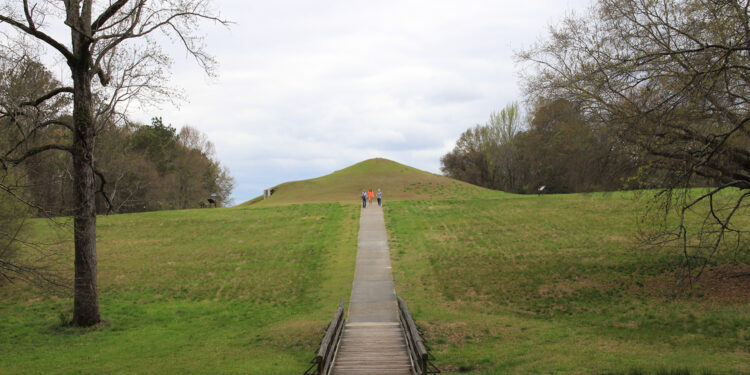Lani Hansen/Senior Reporter
MACON, Georgia– The Ocmulgee Mounds National Historic Park is receiving an additional 951-acres that will protect some of the most significant prehistoric Indigenous mounds in North America.
The national historic park was established in 1936, it preserves and interprets evidence of one of the longest periods of human habitation at any one in the national park system. Ocmulgee Mounds has yielded artifacts from every major period of American Indian history in the Southeast.
According to an Ocmulgee Mounds press release, the 951-acre property is located adjacent to the park and inside the city limits of Macon. The property was under threat of incompatible industrial development before Open Space Institute (OSI) negotiated a deal to purchase the land in 2021. The project will be a major result of an expansion of the park in 2019.
The acquisition is made up of 906 acres and will be transferred to the National Park Service (NPS) immediately, according to the press release. The other 45 acres will be transferred to the Ocmulgee Land Trust during wetlands restoration and then later donated to the park service.
The property is located within the “Ocmulgee Old Fields,” also known as the Macon Reserve. The Ocmulgee Old Fields Macon Reserve is a site revered as a sacred place to the Muskogean people. It is compromised of lands specifically retained by the Muscogee (Creek) Nation from 1805 until the 1826 Treaty of Washington.
MCN Principal Chief David Hill said in a release, “This additional property includes some of our most important unprotected ancestral lands. The Muscogee (Creek) Nation has a long-standing history of preserving the Ocmulgee Old Fields-Macon Reserve. We have never forgotten where we came from and the lands around the Ocmulgee River will always and forever be our ancestral homeland, a place we consider sacred and a place with rich cultural history.”
The park’s striking mounds are marvels of highly skilled Indigenous engineering that today constitute one of America’s most important cultural landscapes. Seven of the mounds can be found at the park, including the 55-foot-high Great Temple Mound, located on a high bluff overlooking the floodplain of the Ocmulgee River. Cornfield Mound is believed to have originally been a ceremonial cornfield, where the mound was built over the field. Earth Lodge is a reconstructed council chamber of the Mississippian culture with the original 1,000-year-old clay floor. The Funeral Mound is a burial spot for elite members of the Mississippian society, originally standing at 50 ft. tall. The McDougal Mounds was built by the Mississippians after Captain Robert McDougal who was in command of Fort Hawkins in 1809 died. Mound X is no longer visible but was found in 1806 and only stood at three feet high at the time. The Southeast Mound is unknown but the oval shape of it is believed to be caused by an erosion and ploughing before the 1930’s.
The Muskogean people who built these mounds spoke unique dialects reflecting lingual divergence from other tribes more than 3,000 years ago, making it the only truly native southeastern language.
“It is our solemn duty and honor to protect our nation’s most significant lands. It’s even more critical that we work collaboratively with Tribal nations to ensure proper conservation and access. The National Park Service will continue to work with willing sellers to preserve the culturally significant land associated with the Ocmulgee Old Fields,” said National Park Service Director Chuck Sams in a press release.
The conservation project was funded by the NPS using Land and Water Conservation Funds, Knobloch Family Foundation through a grant to OSI, Peyton Anderson Foundation through a grant to the Ocmulgee National Park and Preserve Initiative, and the National Park Foundation.
Efforts to protect the park would not be possible without the partnership of the Ocmulgee Land Trust, National Parks Conservation Association, the Nature Conservancy and Georgia Conservancy.





